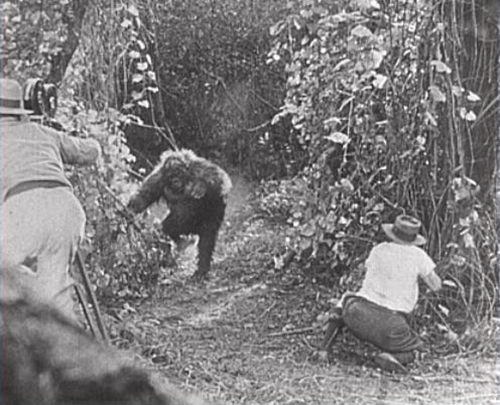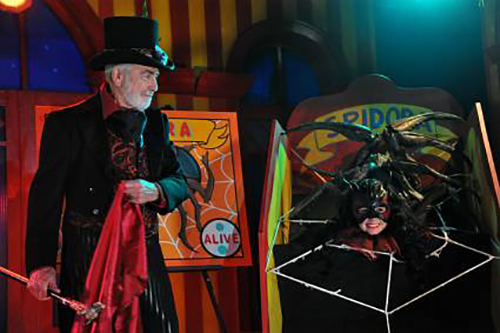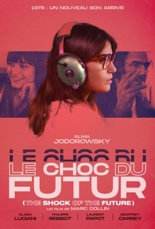
 Not based on the same-named Prince song in which the Prince of Funk meets her in a hotel lobby masturbating with a magazine, Darling Nikki is a transparent allegory of Lewis Carroll’s Alice in Wonderland, dripping in Day-Glo.
Not based on the same-named Prince song in which the Prince of Funk meets her in a hotel lobby masturbating with a magazine, Darling Nikki is a transparent allegory of Lewis Carroll’s Alice in Wonderland, dripping in Day-Glo.
As played by co-writer/co-producer Nicole D’Angelo, Nikki works on a sexy cooking show called Edible Desires. She’s kind of like its Vanna White, if Pat Sajak were allowed to put things in her mouth. She’s also a loving girlfriend to the brilliant Ethan (Donnie Darko’s James Duval, here for name value), who’s very busy working on “something with binary sound waves.” And she’s also a prostitute, whose madame (Elana Krausz, 2017’s Ghost House) talks to a dog statue in her backyard.
“I knew you’d be quite popular,” the madame says as Nikki tucks a dirty wad of foreign bills into her cleavage. “Your parents would be so proud. If only they could see you now.” Indeed! Cue the montage of Nikki with various johns and fellow ladies, engaging in group sex, drinking champagne, having tickle fights, dancing in lingerie, being denied slices of Hickory Farms salami and, most unfortunately for the viewer, eating creamed corn in extreme close-up.
After being violently raped and left foaming at the mouth by a “mean man” some people call Maurice (Steve Polites, 2017’s Dementia 13), Nikki stumbles into an alternate reality. She gets there from the bathtub, thanks to what looks like a basket of Spree, adorned with the note “EAT ME.” Each time she takes one, it sparkles, sending her consciousness down the rabbit hole and to a near-death drowning once she comes to. (The movie’s “DRINK ME” equivalent is a mystery green liquid: Absinthe? Listerine? Hi-C Ecto Cooler?)
In the dreamworld, Nikki is dressed as a scorching-hot vixen version of Disney’s animated Alice. There, she encounters a giggling cat man who licks milk and himself, watches guys in drag and uses the flying guillotine. Back in the real world, events are hardly more lucid: While a celebratory Ethan has cracked the riddle of whatever he’s been doing with those pesky binary sound waves, Nikki’s having a flashback-cum-breakdown over being forced to eat cat food.
 As with the other works of enigmatic director Gregory Hatanaka (Samurai Cop 2: Deadly Vengeance), Darling Nikki marks an unofficial-family affair, using his regular players and co-conspirators; chief among them is the ambitious D’Angelo, increasingly a behind-the-scenes player in Hatanaka’s unnaturally prolific Cinema Epoch productions. She’s written herself a showcase for her striking beauty and an imaginative mind, but the story … well, that’s another story. So many ideas are presented to their own detriment, with none given enough attention to bear fruit — perhaps impossible in an abbreviated showtime of 62 minutes.
As with the other works of enigmatic director Gregory Hatanaka (Samurai Cop 2: Deadly Vengeance), Darling Nikki marks an unofficial-family affair, using his regular players and co-conspirators; chief among them is the ambitious D’Angelo, increasingly a behind-the-scenes player in Hatanaka’s unnaturally prolific Cinema Epoch productions. She’s written herself a showcase for her striking beauty and an imaginative mind, but the story … well, that’s another story. So many ideas are presented to their own detriment, with none given enough attention to bear fruit — perhaps impossible in an abbreviated showtime of 62 minutes.
Put in simplest terms, it doesn’t make any sense. Viewers are given only a sliver of a chance to get their bearings before things go — in Nikki’s own words — “batshit mental-ward crazy.” As with Hatanaka/D’Angelo’s Heartbeat (one of seven collaborations in 2020 alone), overstuffing leads to delirium, as things that aren’t supposed to be funny are, and things that are supposed to be funny aren’t. That may have you wish to borrow another sentence or two from Nikki’s lips — namely, “Oh, enough of this nonsense. … How do I get out here?” — but please, resist that urge. Though baffling and quarter-baked it may be, an earnestness shines through akin to charm. Or something with binary sound waves. —Rod Lott









